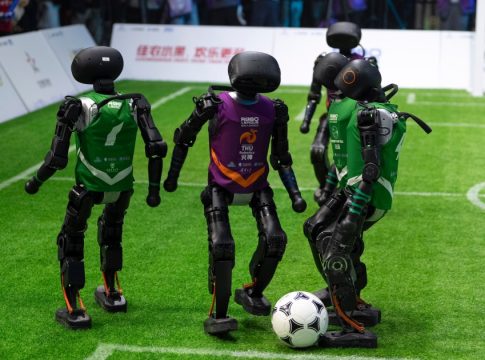Humanoid Robots Hit the Soccer Field: A Fun Look at AI in Action
Wobbling Warriors: The Match in Beijing
Last Saturday, a unique spectacle unfolded in Beijing as humanoid robots faced off in a 3-on-3 soccer tournament. This wasn’t your standard championship match; instead, it resembled a playful day at a kids’ league, complete with wobbly movements, hilarious falls, and frequent pile-ups. Robots stumbled and occasionally toppled over one another, making for a theatrical and comical display rather than the skillful finesse we might expect from professional athletes.
The Tech Behind the Tumbles
Despite the slapstick shenanigans on the field, there’s no denying that significant technology was at play. Each team of child-sized robots operated autonomously, driven entirely by sophisticated artificial intelligence without any human oversight. Equipped with advanced sensors, these robotic players were designed to locate the ball and navigate the field, albeit with a fair amount of clumsiness. Notably, many of them were programmed to right themselves after falling, though a few required human assistance to be carried off the field.
The entire event serves as a testament to the staggering advancements in robotics within China, which is investing billions into this field. Research from Morgan Stanley projects that China’s robotics market is expected to balloon from $47 billion to $108 billion by 2028, with an estimated 302.3 million humanoid robots in use by 2050.
China’s Robotic Advantage
Sheng Zhong, head of industrials research at Morgan Stanley, notes that China is significantly prioritizing "embodied AI," which suggests that their edge in AI and robotics may deepen before other nations, particularly the U.S., can catch up. This commitment is already producing staggering numbers: China is anticipated to field far more humanoid robots than the U.S. by 2050, aimed primarily at repetitive and structured tasks like those found in factories.
Testing Grounds for Future Interactions
Cheng Hao, founder of Booster Robotics, emphasized that sporting events offer valuable testing environments for humanoid technology. Each awkward tumble or unexpected success contributes to refining algorithms and improving hardware-software integration. Safety remains a central concern; as Hao noted, robots engaging with human players will need to be absolutely reliable to ensure safety during matches.
A Glimpse Into the Future
Additionally, this tournament served as an exciting precursor to the 2025 World Humanoid Robot Games, which will feature a multitude of events from soccer to gymnastics. As for the tournament’s results, Tsinghua University’s team triumphantly defeated the China Agricultural University’s Mountain Sea team with a score of 5-3, entertaining a crowd that likely enjoyed the lighthearted chaos more than a typical game.
Robot Entertainment Value
With China’s national soccer team struggling at an unimpressive spot in the FIFA rankings, these robotic athletes might just win over the hearts of fans. While they may not yet rival the skills of seasoned players like Lionel Messi, they certainly delivered a memorable performance that showcased the potential of AI in sports—both for entertainment and technological advancement.
As we watch this field evolve, one thing is clear: the journey from stumbling robots to agile athletes is just beginning, with immense potential lying ahead.

Writes about personal finance, side hustles, gadgets, and tech innovation.
Bio: Priya specializes in making complex financial and tech topics easy to digest, with experience in fintech and consumer reviews.

